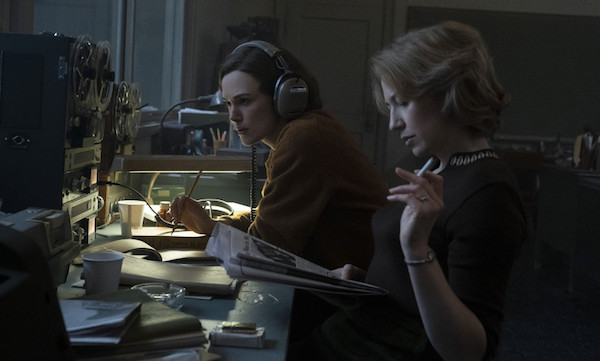Movie review by Greg Carlson
In “Boston Strangler,” writer-director Matt Ruskin revisits the mysteries and inconsistencies of the notorious serial killer’s case, adding another chapter to the onscreen saga of the true crime staple. Featuring outstanding performances by Keira Knightley and Carrie Coon as the journalists who investigated the story for the Boston Record American, Ruskin’s movie will appeal to thriller devotees who enjoy making comparisons between published history and Hollywood versions. Handsomely photographed by Ben Kutchins to take full advantage of the 1960s setting, the movie’s most successful aspect is the way in which Ruskin focuses attention on the sexism and gender-based discrimination faced by Knightley’s Loretta McLaughlin.
The real-life McLaughlin, who died at the age of 90 in 2018, would eventually become the second woman in charge of the editorial page at the Boston Globe and a dogged public health advocate who extensively covered the AIDS crisis. Prior to those milestones, she was the reporter who broke the Boston Strangler story. Determined to treat the content with a stately air of old-fashioned respect befitting the period, Ruskin downplays the most salacious and sensationally graphic dimensions of the murders. The decision mutes the movie’s credentials as a piece of outright horror, but the filmmaker’s close attention to process and procedure offers enough drama to retain viewer interest.
“Boston Strangler” owes a debt to several films that connect a series of killings to media outlets pursuing information and police departments struggling to apprehend the person or persons responsible. In one scene, Ruskin apes the terrifying “lion’s den” encounter from David Fincher’s “Zodiac.” In others, the depiction of the partnership between McLaughlin and Coon’s more seasoned Jean Cole (in real life, the women knew each other long before the Boston Strangler story) rhymes with the team-up of Jodi Kantor and Megan Twohey in Maria Schrader’s “She Said.” In subtler ways, Ruskin nods to the cinematic legacy of Clarice Starling in Jonathan Demme’s endlessly influential “The Silence of the Lambs.”
Unlike Demme’s film, “Boston Strangler” is missing a charismatic and diabolical antagonist on par with Hannibal Lecter. Ruskin, of course, draws his film from nonfiction sources and is further frustrated by the compelling multiple-killer theory that casts serious doubt on claims that Albert DeSalvo (played here by David Dastmalchian) was responsible for all 13 of the murders attributed to the Boston Strangler. The filmmaker does his best to sort out the involvement of the opportunistic inmate George Nassar and the even more opportunistic attorney F. Lee Bailey, but the ambiguity and uncertainty of the still-open cases – DeSalvo’s body was exhumed in 2013 for DNA testing that would confirm his 1964 murder of final verified victim Mary Sullivan – clouds the film with grim stoicism.
To date, the Boston Strangler case has inspired multiple films and storylines on television shows. Given the lack of resolution and the perpetrator’s modus operandi, which eschewed forced entry in favor of posing as maintenance, delivery, or service workers, Ruskin’s take will not likely be the final word. As a version told through the eyes of McLaughlin, however, this interpretation considers the kinds of personal and professional barriers and obstacles overcome by women who operated in male-dominated spaces and refused to accept patriarchal norms and expectations.
